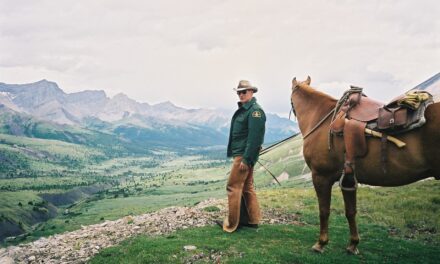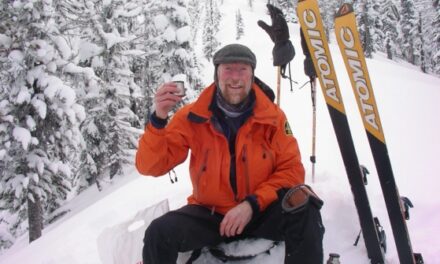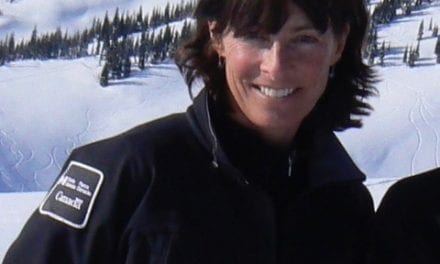MD: What were some of the more memorable events of your warden service career?
Tom: As part of the Public Safety, I was able to get on a couple of the climbing trips up in Kluane – one was Mt. Steele, and the Mount Logan climb. That’s the climb that Tim Auger and Peter Perren had a fall. I was there as well. It was interesting because we had done the whole climb – the trip was climbing the East Ridge of Mount Logan, which Willi Pfisterer was the Alpine Specialist leader for the trip, and he had actually climbed that route as a first ascent with Hans Gmoser in ’53 or somewhere around there. (Wikipedia describes Mount Logan as the highest mountain in Canada, and the second-highest peak in North America after Denali. Due to active tectonic uplifting, Mount Logan is still rising in height. Before 1992, the exact elevation of Mount Logan was unknown and measurements ranged from 5,959 to 6,050 metres (19,551 to 19,849 ft). In May 1992, a GSC expedition climbed Mount Logan and fixed the current height of 5,959 metres (19,551 ft).
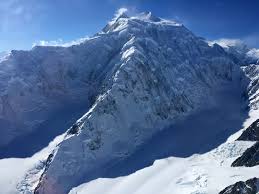
Mount Logan’s east ridge.
So they’d had a previous trip a number of years before that on Mount Logan, but on the standard route. Some of the older guys were on that – I think Clair Israelson was the youngest brand-new guy, but the rest were kind of older, Bob Haney’s vintage. But anyway, on this trip we had climbed to the summit via the East Ridge and had made our way back down and it was the last day coming off the ridge – what we called Camp 1. Four of us out of about 8, only 4 of us continued to the summit, and as we went to the summit, we could see a big storm coming in, so we got to the summit, and got to our high camp, pulled it, and went down as far as we could. It was Tim Auger, Peter Perren, Murray Hindle, and myself. Got caught in the storm, set up the tent, and spent about a day in the tent with the storm going, and it snowed three to four feet or so. Hard to tell with all the wind, but quite a bit of snow, and then it finally cleared, and then we made it down to the rest of the group, who were waiting at Camp 1, which was the first camp up on the ridge.
And so we made it down to the ridge, and then the next day we were breaking camp, and pulling everything down to Base Camp. We left one tent, and Peter Perren and I were teamed together the whole time, and Murray Hindle from Jasper was teamed with Tim. That last morning leaving, Murray Hindle came to me, and said, “I don’t want to rope with Tim today.” So we roped together, and Peter roped with Tim. We were all short-roped, going down walking together down the ridge, but there were steps that were steep. They were a little bit icy, but then it’d be easy-going again, but it’s a knife ridge, so it’s basically 1800 feet down both sides. I say a “knife”, but we had some room to walk, but it went down both sides. Willi went in the lead with Ron Chambers – they were breaking trail, and it was easy going for the most part – it was deep snow. Because of it, I had ski poles, and Murray Hindle had his ice axe. And so Willi went ahead, and we were the second team, and we went through it. We had cut steps in it when we came up, and it was blowing a little bit clearer even with all the snow. Once you got down a step, the flat spot was sheer ice. Right behind me were Peter Perren and Tim. So Peter came first, and Tim after, and a step broke out on Tim. And I was just ahead, so I heard Tim holler, and I was maybe 5 or 6 feet away from Peter, and I tried to get back to him. He had an ice axe, and Tim had ski poles. So he couldn’t arrest himself much with ski poles – they were great for the deep snow, but…Peter tried to jam his ice axe in, but it was just sheer ice, hard ice. I tried to get back to support him, but Tim went flying past him right down this gully, and you could see the rope go taut and it held for a little bit, and I couldn’t get…I was probably this far – 3 to 4 feet away from Peter, and he was shot out of there, and catapulted past Tim, and they leap-frogged down the gully.
You could probably see maybe a third of the way down the gully before they went out of sight, and they started an avalanche. And they were going from side to side – Tim was trying to get the rope hooked on a rock just to stop them, but what saved them really was all the new snow in the avalanche. Seeing that, you just thought …well, that’s not going to work out too well. You’ve picked up folks that had a thirty feet fall and they were dead…so anyway we still had some guys above, and we left one tent with some equipment and a single side band radio in the tent above. So Willi had the guys who were above that step go back and call and radio for a helicopter to come in. And then Willi’s rope and my rope – we continued down the ridge to try to get to the guys. We could see the avalanche run out the bottom, and a big cloud of snow and everything. We we’re continuing down the ridge, I don’t think each team had a radio, but we had a few, and Tim had one.
And suddenly Tim came on the air, and says “We’re OK”! When they landed, Peter was on top of the snow – he was half buried, and Tim was totally buried, so Peter had to follow the rope to Tim, and started digging him out, and meanwhile, Peter, with one leg injured at the knee which was quite damaged, and it was almost torn off, unusable, and so he was dragging his leg. And then he got to a heel, Tim’s heel with the boot, and then it was kicking, and then it stopped kicking. He dug him out and he was ok. Tim came to and he had some painkillers. We still had quite a distance to go along the ridge and then just when we were going to head down the side to get to the bottom, the helicopter came in.
The chopper toed in on the narrow ridge and picked up Ron Chambers to go over and load the guys up, the three of us roped together and continued down the slope, and the other team members at Camp 1 were Heli lifted down to Base Camp. Anyway, they flew them into the hospital, right into Whitehorse. The helicopter came from Haines Junction. Whitehorse would have been the only hospital. There was a nursing station at Haines Junction, but that’s it. They had a lot of luck to fall that distance, the snow helped them I guess – cushioned it somewhat.
Those were two (memorable incidents) – those climbs (climbs Mt. Steel and Mt. Logan). Also while I was in Jasper, I was involved with the first prescribed fire that Parks Canada had done, and it was east of town, out towards the Palisades. Most of the planning had been initiated prior to me getting assigned to the project, but I got involved with that and organizing that. Then I was also involved in the Bison Transplant that we had in Jasper, which didn’t turn out too well. It was a joint project between Parks Canada and the Canadian Wildlife Service. Hal Reynolds at the time was the CWS bison biologist. I think it was 25 bison that they took into Willow Creek – we kept them in a compound for a month – kind of like a paddock and fed them a little bit of hay when they needed once they ate all the good feed up. And then released them. Anyway, there was quite a few things that they learned not to do – ha!
MD: Where did the bison come from?
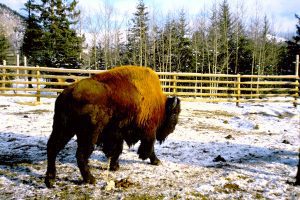
Bison, in Banff Warden Service corrals. Photo by John Nylund.
Tom: Elk Island, it was the late 1970’s – we learned a lot from the project. The Canadian Wildlife Service did other successful Bison transplants in other Provinces after that. The Grasslands Bison Reintroduction project had the benefit of the Jasper mistakes.
MD: So what happened to the bison up in Jasper?
Tom: Well – most of them went north and one of the big mistakes was really the CWS wanted this perfect little herd structure – old cows down to calves, and one of the old wardens in Elk Island (Fred Dixon) said those old cows are just going to try to get home, and that’s what they did. They have quite a homing instinct, so they went north and continued north out of the park into the Willmore Wilderness and further north into agricultural country where they finally ended up…And I ended up on holidays, so I was away, but Dave Norcross was involved in it also at the time, he assisted and they came out from Elk Island (Fred Dixon and others), put up portable corrals and fed them hay, and guided them right in, and took them back to Elk Island. They didn’t all go back home – we lost some of the bulls as they dispersed right away, and one bull actually went right down to the Athabasca Valley and east of town, wintered at the Mushroom Patch, and he wintered there for a number of years. He’d go up the Beaver Valley in the summer and come back and winter down in the Athabasca River. But he was all by himself. They could have planted a few with him, but they were pretty freaked that he was down by the (highway?). Apparently they didn’t want Bison in the Athabasca Valley. It was an interesting project. That was in the late 70’s. There’s a little report in the Warden Office in Banff on it, but I can’t remember the exact year.
MD: Are there any rescue related, or enforcement stories that stick out in your memory?
Tom: I guess a highlight was also when we used to go into the Calgary Stampede parade with the horses. That was initiated for the National Parks Centennial, so they started that a couple of years before that, and went into some of the smaller parades, and then continued with the Calgary parade for about ten years. So I was involved with that and keeping it going. And then we tried to make it more a Park initiative and not just the Warden Service but there was no interest, …I know Banff Maintenance guys had a float, but no one wanted to do it, and eventually it fizzled out. The reception we received from the public was amazing and it was a very good Public Relations initiative.
MD: They still go in the Banff and Canmore ones. They don’t do the Stampede anymore?
Tom: No – not that I’m aware. Brad White got involved and kept it going for a little while also. It was a good thing to show the flag – a good National Parks thing, and folks really liked it as well.
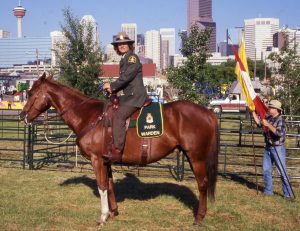
Cyndi Smith photo. Calgary Stampede Parade.
One of the enforcement things was when I was in Jasper, and still living at Mile 45 – I got a call one day of a biker gang at the Icefields, and to head south and look after it, they were at the old Icefields Chalet, and they had apparently taken gas and didn’t pay, and took things inside in the restaurant, and didn’t pay…
MD: At the Icefields Centre?
Tom: Yes…the older chalet which was quite a bit smaller.
MD: So you were all alone?
Tom: All alone, yes…so I headed south in my old Dodge truck, as slow as I could go…a .308 beside me, a rifle, and they were coming from town with 3 or 4 RCMP patrol cars and wardens. And Duane Martin was the head of law enforcement at the time in Jasper. He was the one that called for me to proceed south, and see if I could see these guys.
MD: So they were coming north from the Icefield?
Tom: Well, they were still at the Icefields area when Duane called. Anyway, I continued south, and I just got past Tangle Creek Falls, and then there’s a bit of a hill, and you hit the flats there, and I could see the bikes all coming around the corner from the Icefield – all these bikers, so…and at the same time, right behind me came the RCMP patrol cars, one of the RCMP had actually worked with the biker gangs previously and knew of the group. Anyway, they dealt with it and they (the bikers) had an accompanied camper with them in which they found handguns and some firearms. And some of the guys had slung on their backs, shotguns and shell belts. I guess they raised quite a bit of trouble down at Saskatchewan Crossing – one of the campgrounds.
